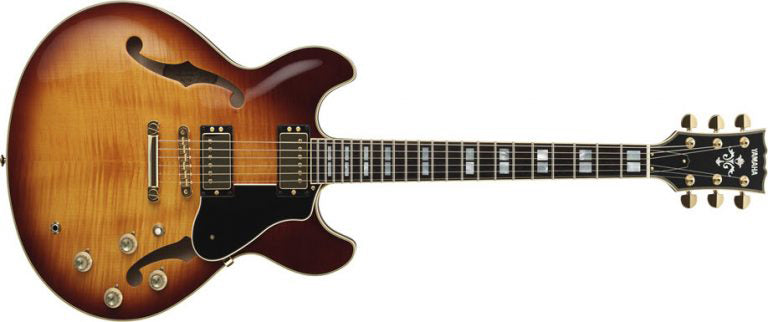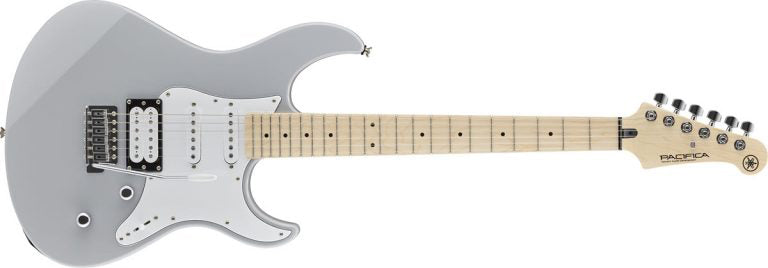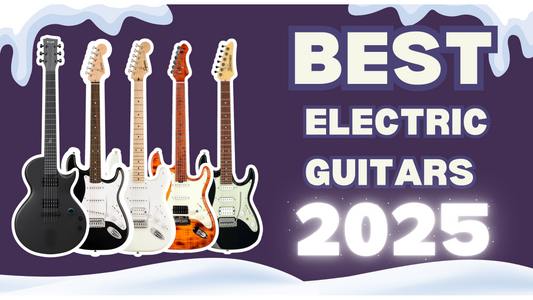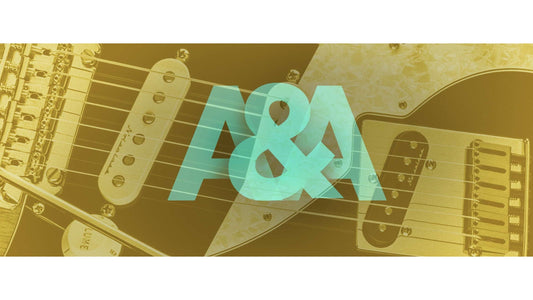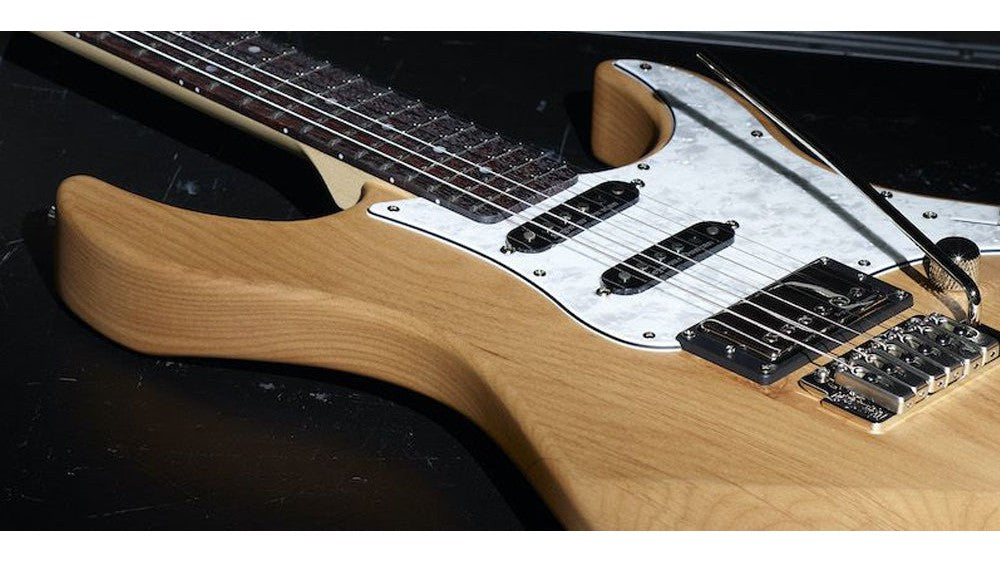
Các Loại Gỗ Làm Đàn Guitar Điện / Bass
Các loại gỗ làm nên đàn guitar điện / bass, đặc biệt các bộ phận như thùng đàn, cần đàn, bàn phím... có quan trọng trong việc tạo ra chất lượng âm thanh của đàn không? Hay đơn thuần quan trọng nhất chỉ là những chiếc pickup?
Ngay cả những người không biết nhiều về guitar cũng hiểu rằng chất liệu gỗ được sử dụng làm nên một cây đàn guitar thùng sẽ ảnh hưởng trực tiếp tới chất lượng âm thanh của nó.
Tuy nhiên, khi nói đến guitar điện / bass, điều này rắc rối hơn một chút. Bởi vì ngoài chất liệu gỗ, yếu tố chính tạo nên chất âm của guitar điện / bass thùng đặc là những chiếc pickup của nó. Liệu bạn có cho rằng guitar điện / bass có thể được chế tạo từ bất kỳ vật liệu nào và vẫn cho âm thanh tốt. Vì vậy, tại sao phải quan tâm đến các chất liệu gỗ? Guitar điện / bass được làm từ loại gỗ nào có thực sự quan trọng?
Câu trả lời cho câu hỏi đầu tiên là: Cần quan tâm tới gỗ được sử dụng trong guitar điện / bass vì các yếu tố như cảm giác, trọng lượng và ngoại hình cũng quan trọng đối với các nghệ sĩ guitar không kém gì âm sắc. Ngoài ra, các đặc tính cộng hưởng của gỗ - đặc biệt là gỗ được sử dụng trong thùng đàn - vẫn có tác động đáng kể đến độ ngân của âm thanh.
Đối với câu hỏi thứ hai, câu trả lời là: Điều đó thực sự quan trọng, bởi vì do sự pha trộn đặc biệt của từng loại gỗ với những yếu tố được đề cập ở trên, một số loại gỗ sẽ mang lại chất âm tốt hơn cho đàn guitar điện / bass.
Dưới đây là 3 loại gỗ thường được sử dụng nhất trong guitar điện / bass hiện đại, được chia thành ba phần cốt lõi của mỗi cây đàn - thùng, cần và bàn phím. Mỗi bộ phận yêu cầu các đặc điểm khác nhau nên cần các loại gỗ khác nhau.
CÁC LOẠI GỖ DÙNG CHO THÂN ĐÀN GUITAR ĐIỆN / BASS.
Cách thân gỗ cộng hưởng khi dây rung động là yếu tố then chốt tạo nên âm thanh của bất kỳ loại guitar nào, dù là acoustic hay điện. Đó là lý do tại sao, gỗ Rosewood dù là phiên bản nào cũng được những người thợ làm đàn quý trọng. Loại gỗ này cộng hưởng tốt tạo ra độ ấm tuyệt vời, tạo ra nhiều lớp âm làm nên độ dầy của tiếng đàn. Tuy nhiên, vì Rosewood được quốc tế xếp vào loài có nguy cơ tuyệt chủng, việc buôn bán của nó bị hạn chế, nên việc chế tạo một cây đàn hoàn toàn bằng gỗ Rosewood rất tốn kém. Nếu có thì cây đàn toàn bằng gỗ Rosewood cũng sẽ gây khó khăn cho lưng và vai bạn khi biểu diễn vì nó rất nặng.
Đó là lý do tại sao các nhà sản xuất guitar điện / bass có xu hướng tìm kiếm loại gỗ kết hợp các đặc tính âm sắc tốt với trọng lượng hợp lý và giá thành dễ chịu. Từ nhẹ nhất đến nặng nhất, các loại gỗ thường được sử dụng cho thân đàn guitar điện / bass là:
- American ASH
- South American Alder
- Asian or South Pacific Agathis
- American or Canadian Maple
- African Mahogany
Mahogany chỉ đứng sau Rosewood cả về độ phong phú về âm sắc và trọng lượng của nó; Các loại Mahogany từ Châu Phi là một trong số ít dòng Mahogany không được xếp vào loại có nguy cơ tuyệt chủng. Các dòng Agathis có âm sắc tương tự như gỗ Mahogany nhưng không nặng bằng.
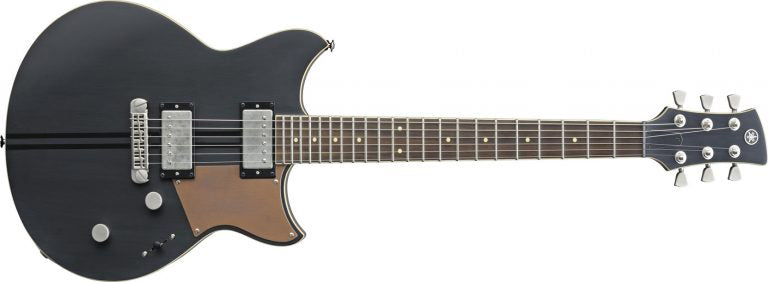
Yamaha REVSTAR RSP20CR.
Đàn điện thân rắn Yamaha REVSTAR Series có thân bằng gỗ Maple/Mahogany hoặc gỗ Flame Maple (Gỗ Phong lửa - một loại rất được yêu thích). Hầu hết các model trong Dòng Yamaha Pacifica đều có thân bằng gỗ Maple, cây Alder, Flame Maple, hoặc một số model được kết hợp từ các loại gỗ này. Ngoại lệ duy nhất là mẫu PAC1611MS Mike Stern đặc trưng, có thân làm từ Light Ash và PAC012 có thân được làm hoàn toàn từ Mahogany.
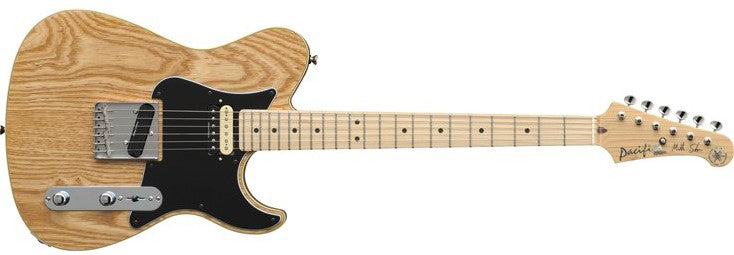
Yamaha PAC1611MS
Đối với guitar điện thân rỗng, tính toán của thợ làm đàn có phần thay đổi. Ở đây, đặc tính âm sắc của gỗ trở nên quan trọng hơn, và trọng lượng ít được quan tâm hơn. Đàn điện Yamaha SA2200 thân rỗng sử dụng gỗ Sưa nhiều lớp (laminated Sycamore), với khối trung tâm bằng gỗ Maple nhẹ hơn để giúp tạo ra sự cộng hưởng và ổn định.
CÁC LOẠI GỖ LÀM CẦN ĐÀN GUITAR ĐIỆN / BASS.
Trọng lượng của cần đàn guitar mặc dù khá đáng chú ý nhưng không quan trọng bằng cách gỗ tương tác với tay người chơi như thế nào. Cần đàn phải đủ cứng để duy trì ổn định và chịu được nhiều năm sử dụng, nhưng cũng cần đủ mềm để tạo cảm giác thoải mái. Gỗ Maple của Mỹ hoặc Canada là một sự lựa chọn tốt và thường được sử dụng cho cần đàn guitar điện / bass, cùng với gỗ Mahogany Châu Phi và Nato, một loại gỗ mềm hơn từ Indonesia.
Hầu hết các cây đàn Yamaha dòng REVSTAR đều có cần bằng gỗ Mahogany (ngoại lệ là các mẫu RS320 và RS420, tùy chọn có sẵn với cần Nato), trong khi các model dòng Pacifica đều có cần bằng gỗ Maple; SA2200 thân rỗng có cần làm hoàn toàn bằng gỗ Mahogany.
CÁC LOẠI GỖ LÀM BÀN PHÍM GUITAR ĐIỆN / BASS.
Trong ba thành phần gỗ chính của một cây đàn guitar điện / bass, bàn phím bị mài mòn hàng ngày nhiều nhất. Do đó, điều quan trọng là phải sử dụng loại gỗ càng cứng và bền càng tốt. Các ứng cử viên chính bao gồm:
- Palisander (một biến thể của gỗ cẩm lai Ấn Độ, hiện được khai thác chủ yếu từ Châu Phi do các hạn chế quốc tế)
- American Maple hoặc Canada Maple (gỗ Phong lửa là phổ biến nhất, nhưng gỗ Phong hình mắt chim cũng được sử dụng thường xuyên)
- Gỗ Mun (Ebony) Châu Phi và Đông Nam Á
- Rosewood: Một trong những lý do gỗ Rosewood là một vật liệu tuyệt vời cho bàn phím guitar là độ bền đặc biệt của nó. Nó không bị phai màu hoặc hao mòn như nhiều loại gỗ khác. Ngoài ra, nó tạo ra dầu tự nhiên nên không cần phải sơn bảo vệ. Tinh dầu tự nhiên này làm cho gỗ Rosewood trở nên mịn màng và mềm mại dưới những ngón tay của nghệ sĩ guitar.
- Pau Ferro: Loại Gỗ này đặc hơn Rosewood.
Đàn guitar điện thân rỗng Yamaha SA2200 có bàn phím bằng gỗ Mun, trong khi tất cả các đàn thân rắn của Yamaha đều chọn gỗ Rosewood với hai trường hợp ngoại lệ: Pacifica PAC112VM, có bàn phím bằng gỗ Maple và Pacifica PAC012, có bàn phím làm từ Rosewood hoặc Walnut (gỗ Óc Chó).
